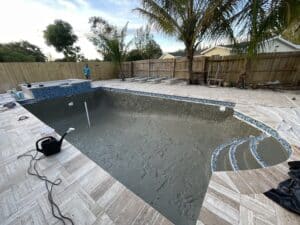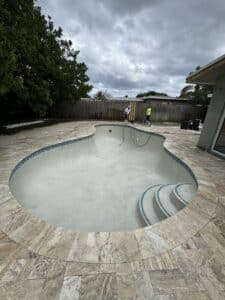The Importance of Pool Safety: A Primer
Swimming pools beckon with their sparkling waters, offering a haven of refreshment and joy, especially during scorching summer days. However, amid the splashes and laughter, it’s imperative to maintain sight of the paramount importance of pool safety. This comprehensive guide delves into many practices, from meticulous water testing to strategic equipment installation. Adhering to these practices can create an environment where accidents are minimized and water quality remains pristine, ensuring a secure and enjoyable swimming experience.

Understanding the Need for Water Testing and Quality Control
Picture the glistening pool waters inviting you for a swim. Beneath this enticing surface, water quality is a silent sentinel. Regular water testing is the sentinel’s vigilant watch, protecting the pool’s sanctity. The pH levels, chlorine concentration, and water balance are not mere technicalities but guardians of your health and enjoyment. When these parameters sway from their optimal points, they can result in discomfort, skin irritations, and illnesses. Water testing isn’t just a task; it’s a pledge to maintain a space where swimmers can indulge without apprehension.
Layers of Protection: Safeguarding Your Pool Area
A secure swimming environment extends beyond the shimmering pool waters. It begins with the establishment of layers of protection around the pool area. Installing proper pool fencing and self-latching gates isn’t merely about compliance; it’s about forming a barrier against potential hazards. Fences standing at least four feet high demarcate a realm of safety, deterring unauthorized access. When gates self-latch, they declare an unyielding commitment to keeping children away from the allure of the water’s edge. Yet, these physical measures alone aren’t the sole sentinels. Pool alarms assume the role of vigilant watchers, sounding an alert if anyone dares to breach safety boundaries.
Educating for Safety: Swim Lessons and Water Precautions
The waters beckon and it’s essential to answer the call with confidence. Swim lessons aren’t just a rite of passage but lifesaving tools. They infuse swimmers, particularly the young, with a life-enhancing skillset and a fundamental understanding of water safety. These lessons forge a bond between the swimmers and the waters, one that’s grounded in respect and awareness. Furthermore, every plunge into the pool should be preceded by precautions. The art of entering and exiting the pool safely, the wisdom to abstain from reckless running, and the humility to abide by pool rules are integral elements in the safety symphony.

Staying Compliant: Essential Pool Rules and Regulations
As the pool is a gateway to delight, it must also embody a haven of order. Pool rules, meticulously curated and diligently enforced, serve as the pillars of this order. These rules aren’t just inked on paper; they’re the guardians of harmonious coexistence in the pool environment. Age-specific rules cater to the unique needs and understanding of different age groups, ensuring that the pool remains inclusive. Yet, even as we immerse ourselves in the waters, the often-overlooked pool drains are potential pitfalls. The proper functioning of these drains isn’t a footnote; it’s a commandment. Ensuring that drains are appropriately covered and working ensures that the waters remain inviting, not treacherous.
Preventing Accidents: Guidelines for Pool Drain Safety
The pool drain—is unassuming yet harboring hidden dangers. A seemingly innocent fixture can wield a powerful force capable of entrapping swimmers, especially the unsuspecting young. Recognizing the potential risks intertwined with pool drains is the first step toward accident prevention. But recognition is only the initial stride; action is the subsequent one. Installing anti-entrapment drain covers is akin to installing guardians of safety. These covers deftly distribute suction force, minimizing the risk of entrapment and creating a more secure aquatic haven.
Water Quality Matters: Testing and Maintaining Your Pool Water
Crystal-clear and inviting water is the soul of the pool experience. Its quality extends beyond visual aesthetics; it intertwines with health and safety. Regular water testing emerges as the sentinel that guards this quality. A symphony of pH levels, chlorine concentrations, and harmonious balances is orchestrated through these tests. The wrong note can lead to discomfort, eye irritation, and, worst cases, infections. Maintaining the water’s chemical equilibrium isn’t a chore; it’s a pledge to craft an aquatic haven where every splash celebrates health.
Environmental Considerations: Protecting Your Pool and Beyond
As the pool basks in the sunlight, its splendor harmonizes with the environment. In this delicate balance, environmental responsibility emerges as a guiding principle. Adhering to guidelines set forth by the Environmental Protection Agency (EPA) signifies an alliance with nature. Through responsible chemical usage, we pledge to safeguard the waters and the ecosystems they touch. Avoiding the introduction of heavy metals and harmful chemicals is not just a choice; it’s a responsibility we bear for generations to come.
Safety Gear: Life Jackets and More
Imagine the pool as a stage and life jackets as the unsung heroes behind the scenes. These unassuming safety devices, when properly fitted, assume the mantle of guardianship. Life jackets are the bridges between potential hazards and safety for non-swimmers and young children. Educating swimmers on the meticulous art of wearing life jackets enhances their value, ensuring they become true lifesavers in critical moments.

Closing and Securing: Pool Safety Measures After Use
As the sun sets on a day of joyous swimming, the importance of safety never fades. Closing and winterizing the pool aren’t mere rituals; they’re acts of preservation. They ensure the waters rest securely during the off-season, awaiting the next season of laughter. The role of self-latching gates continues with the last splash; it persists as the security gatekeeper, ensuring that the pool area remains inaccessible when not in use.
These comprehensive guidelines form a tapestry of safety and water quality, meticulously woven to ensure a secure and enjoyable swimming environment. By adhering to these practices, you aren’t just safeguarding lives; you’re shaping a sanctuary where the symphony of splashes resonates with happiness, and every dive affirms well-being.
Specializing in all things pool services, the team behind Finns Pool Services brings more than just technical expertise to West Palm Beach. Rooted in family values, this full-service company has not only built a legacy in top-notch pool care but also prides itself on its vast team of experts and its unwavering commitment to professionalism. With countless successful pool projects under their belt, they stand as a beacon of trust and quality in the heart of Florida. Dive into a world where dedication meets the deep end.




